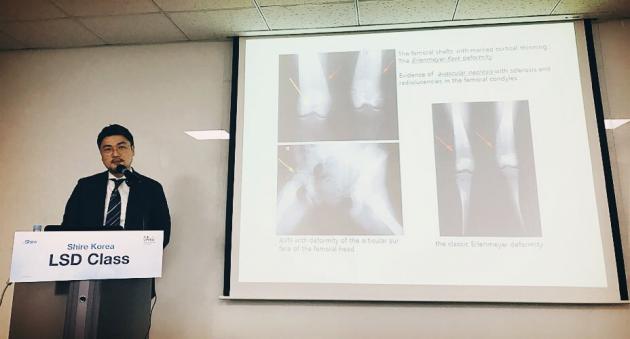Although several therapies for Gaucher disease exist, most take an hour to administer. That may soon change with Shire’s new method, which reduces drug-infusion time for Gaucher disease patients.

Gaucher disease is a rare genetic disorder, classified into three clinical subtypes, wherein an enzyme called glucocerebrosidase does not work correctly and cannot break down a lipid called glucocerebroside. Glucocerebroside then accumulates in the body and affects various parts, including the bone marrow, liver, bone, lung, and spleen, among others. Type 1 is the most common and less severe. Type 2 and 3 are more severe because they affect the brain and spinal cord.
In Korea, there are about 70 people with Gaucher disease. About 30 people have type 1, 15 people have type 2, and 25 people have type 3, said Professor Lee Beom-hee from Asan Medical Center’s Medical Genetics Center, at a news conference Monday.
People with type 1 Gaucher disease adhere to a lifelong commitment of enzyme replacement therapy (ERT) that requires them to visit hospitals or administer the treatment at home every two weeks. Each ERT session takes at least an hour, which is a significant disadvantage compared to orally taken medicines.
“Around 50 people in Korea are currently getting treatment for Gaucher’s disease,” said Professor Lee while noting that several ERT therapies, including Sanofi’s Cerezyme (Imiglucerase) and Shire’s Vpriv (Velaglucerase alfa), are on the market. "As for which ERT therapy the patient will choose, it will most likely depend on convenience, safety, and slight differences in chemical factors."
Shire Korea is focusing on convenience as its selling point. Lee said it expects to cut down the time of Vpriv administration soon from one hour to 10 minutes based on new research findings.
Professor Lee referred to the RAPID IV study led by Professor Ari Zimran from the Hadassah-Hebrew University Medical School in Jerusalem, which found a new protocol allowing a quicker and equally safe administration of Vpriv to Gaucher patients at a hospital or home.
Lee noted that the study is showing “excellent treatment results” with little side effects. The new protocol may point to improvements in both a patient’s quality of life and decreased costs.
“Patients can come to the hospital, and get the injection and go straight home,” Professor Lee said. “It is proving safe, and if the clinical trial is approved, then we will also work to use the method that allows for quick injection.”
The findings were published in the article titled Reduction in Intravenous Infusion Duration of Enzyme Replacement Therapy to Ten Minutes with Velaglucerase Alfa in Adult Patients with Type 1 Gaucher Disease.
Lee also noted the difference between Cerezyme and Vpriv, saying, “Unlike imiglucerase, which is based on animal enzymes, Vpriv is based on human ones, making it closer to human enzymes.”

